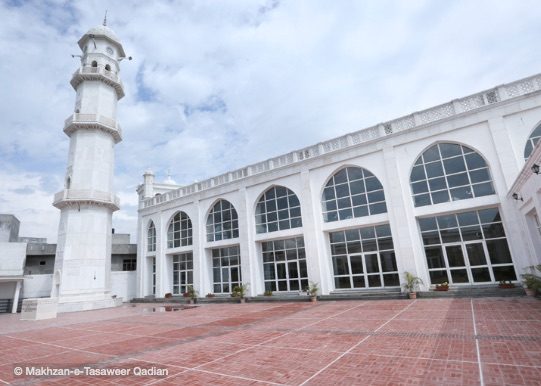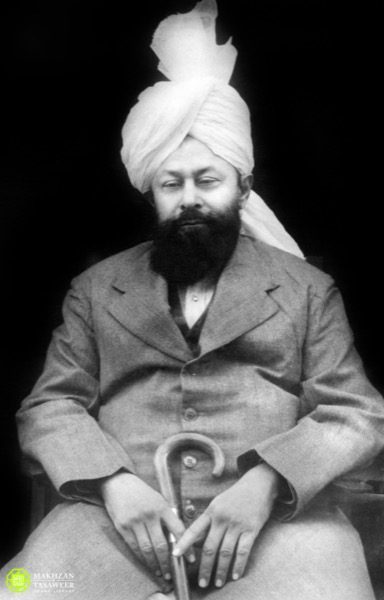
By Professor Amtul Razzaq Carmichael, UK
The land of Afghanistan, in particular Kabul is no stranger to violence, death, and destruction. Afghanistan has a long and chequered past full of tragic events. These tragedies have a special significance for Ahmadi Muslims because of the prophecies of Hazrat Mirza Ghulam Ahmad of Qadian, the Promised Messiah (as).
In his epic work of theology, Barahin-e- Ahmadiyya, he (as) penned a Divine prophecy hinting at the brutal martyrdom of two of his followers. The prophecy stated that two goats would be sacrificed. This prophecy was fulfilled by the barbaric murder of two Ahmadis in Afghanistan under immensely cruel conditions. Hazrat Sahibzada Sayyad Abdul Latif (ra), a revered and esteemed chief of Khost in Afghanistan was martyred by stoning and Hazrat Mian Abdul Rahman (ra), one of the most trusted pupils of the Sahibzada, was martyred through strangulation merely for accepting the Promised Messiah (as). The brutality of these events was such that the Promised Messiahas wrote a book called “Tadhkirat-ush-Shahadatain” (the narrative of two martyrdoms) in 1903 graphically relating two of the most heinous murders in the name of religion.[i]
Hazrat Sahibzada Sayyad Abdul Latif (ra) visited Qadian to investigate the claim by Hazrat Mirza Ghulam Ahmad of Qadian that he was the Promised Messiah (as),and was appointed by God for the reformation of the people of the latter age. After careful inquiry and analysis, Hazrat Sahibzada Sayyad Abdul Latif (ra) became convinced of the truthfulness of this claim and took the oath of allegiance to the Promised Messiah (as). After spending a period in Qadian, he travelled back to Afghanistan. The Amir of Kabul became aware of the visit to Qadian; the Amir invited Hazrat Sahibzada Sayyad Abdul Latif (ra) to the capital on false pretences. The Amir assured him that he would like to learn more about the claim of the Promised Messiah (as); and if convinced, would happily accept the claim.
When Hazrat Sahibzada Sayyad Abdul Latif (ra) arrived at Khost, eight government officials escorted him to Kabul nearby. The Amir treated him with immense disdain. In a most derogatory manner, the Amir told his officials to make him stand far away from him, claiming that he could smell a stench coming from him. Shortly afterwards, Hazrat Sahibzada Sayyad Abdul Latif (ra) was imprisoned in the grounds of Amir’s residence. In the prison, he was put in shackles called ‘Ghargharaab’, which is a very heavy chain of iron weighing about 130 pounds. It is put round the neck and the waist, and the prisoner is handcuffed. The Amir also ordered that an additional shackle weighing 17 pounds be placed around his feet. He was then tortured in this state of captivity for four months.[ii] He was regularly harassed and coaxed to renounce Ahmadiyyat. It was promised that if he renounced Ahmadiyyat, the Amir would restore his rightful place in the religious hierarchy of Afghanistan. He declined to do so and affirmed his faith despite these immensely difficult and inhumane conditions.
Consequently, he was charged with apostasy and heresy by a religious court. At the Royal Mosque, a dialogue was held between him and eight official clerics; the arbitrator was a doctor who was a staunch adversary of the Ahmadiyya Muslim Movement. The papers of this trial have never been published. During the trial, Hazrat Sahibzada Sayyad Abdul Latif (ra) was asked questions by the clerics, and he had to write his answers surrounded by eight soldiers standing over him with their unsheathed swords drawn over him. At the end of the so-called trial, a verdict of apostasy was issued. The Amir of Kabul approved this verdict without examining any papers or listening to any further arguments. He was then sent back to prison. The next week, the Amir of Kabul summoned him for an audience in his court in front of a large gathering.
It is most faith inspiring to read the account of that audience in the words of the Promised Messiahas, who explains the exchange that took place between those two: “The verdict of apostasy has been passed on you. Now say whether you will repent or face the penalty? Hazrat Sahibzada Sayyad Abdul Latif replied in a positive and unequivocal manner: I cannot retract from the truth; should I accept a falsity for fear of my life? No, that I will never do. The Amir tried hard to persuade him to retract and gave him his personal promise of freedom and favours. But the Sahibzada persistently rejected the overture and said: You must never expect that I will ever retract from the truth.”[iii]
Hazrat Sahibzada Sayyad Abdul Latif (ra) was sentenced to death by stoning. On the day of the execution, he was dragged like an animal to the site of his execution by putting a rope through his nose. He was buried in the earth up to his waist and was asked several times to denounce Ahmadiyyat to escape this violent death but he declined to do so. At the behest of Amir of Kabul, the religious leader threw the first stone followed by a barrage of stones thrown by the public resulting in brutal martyrdom on 14th July 1903.
This fulfilled the prophecy of the Promised Messiahas regarding the sacrifice of two goats. Commenting on this sacrifice, he (as) explained that, during their lifetime, goats nourish others with their milk and in the same way, Hazrat Sahibzada Sayyad Abdul Latif gave the people of Afghanistan the milk of spiritual knowledge and wisdom by explaining to them the concepts of Jihad, death of Jesusas and the advent of the Promised Messiahas. Like goats, he was sacrificed in a brutal and inhumane way.[iv] The Promised Messiah (as) lamented at the violent martyrdom of an innocent man at the hands of religious clerics, politicians and the public. He wrote: “O land of Kabul! you are a witness to the heinous crime committed on your soil. O miserable land! you have, in the sight of Allah, been condemned as you are the scene of this most atrocious crime.”[v]
The unfortunate land of Kabul has been the site of murder, bloodshed, violence, and extreme brutality ever since. After the brutal martyrdom, a deadly epidemic of cholera broke out in the city killing hundreds and thousands of people including the members of the ruling family. In 1919, in a violent power struggle the Amir Habib Allah Khan was assassinated and his son was hanged. In 1921, bloodshed continued during the third Anglo-Afghan War. Bitter infighting and dissent led to further regime changes and killings in 1923, and murderous infighting between various warlords continued. In 1980, Afghanistan was invaded by Russian forces. After a period of incredibly violent fighting, murder, and bloodshed, Soviet forces retreated in 1989 after loss of more than 50,000 Russian soldiers. In 1994, Taliban forces started to create havoc in the country leading to murder, torture, and anarchy. After the events of September 11, 2001, US forces invaded Afghanistan.[vi] It is estimated that 241,000 people died as a direct result of this war. This does not include the death of hundreds and thousands of civilians who died of hunger, disease, and injury during this devastating war. On top of that, it is estimated that 66,000 to 69,000 Afghan military and police lost their lives during these two decades. The number of rebels who died during the war, including Taliban fighters, is estimated to be 84,191.[vii] The recent insurgence in violence after the withdrawal of the Western Forces and increased Taliban activity is only likely to add to these sad and depressing figures.
The upcoming trajectory of events in Afghanistan appears to be horrific. Violence, murder, bloodshed, and anarchy appear inevitable. The human cost of war in Afghanistan is immense. Does it have to be this way? Would the unfortunate land of Kabul always remain a seat of violence and murder and stay deserted, ruined, dangerous, and destitute? Is there any hope of peace in this condemned land of anarchy, violence, and bloodshed? Is there a way out for the innocent civilians of Afghanistan to build a life with some semblance of normality? Would we ever see Afghan men, women and children grow happily, prosper, and achieve their full potential?
The history of religious movements bear witness that the sacrifice of martyrs paves the way for a long succession of triumph and victory. Afghanistan was the first land to misinterpret the laws of shariah and kill innocent souls for accepting the Messiah of the latter days, alleging that they were apostates. This incorrect interpretation of Islam has consumed the life of Afghan individuals, bringing pain and misery to millions of Afghans, particularly women. A clear understanding of true Islam attained by accepting the Messiah of the time will set the people of Afghanistan on the path of peace.
The Promised Messiahas says:
“I saw in a vision that a large, green and flourishing branch of a cypress tree in our garden had been cut down and someone was holding it in his hand. Then I heard someone saying: Plant this branch in the land near my house in the place of that which has been cut. It will grow again. At the same time I received the revelation:
‘… کابل سے کاٹا گیا اور سیدھا ہماری طرف آیا
[Urdu] Was cut off from Kabul and came straight to us.’
I interpreted this to mean that the blood of the deceased, martyr [Sahibzadah ‘Abdul-Latif ra], has fallen upon the ground like a seed and would become very fruitful and would add to the numbers of our Community.”
Thus, accepting the message of the Messiah of the time, in accordance with the teachings of the Holy Prophetsa holds the key to resolving violence in Afghanistan.
May the people of Afghanistan be enabled to accept the Messiah of the time, may the blessings of the martyrdom of Hazrat Sahibzada Sayyad Abdul Latif become evident. May God transform Kabul from being the land of condemnation and violence to a land of peace and prosperity. Ameen.
About the Author: Professor Amtul Razzaq Carmichael MD, MEd, FRCS (Gen Surg.), MBBS, is a consultant. She qualified in 1987 with gold medals for academic excellence and undertook her surgical training at major teaching hospitals in London, Edinburgh, and Philadelphia. She has authored many articles for major peer-reviewed scientific journals. She is a senior member of The Review of Religions Editorial Board as well as Assistant Manager.
Endnotes
[i] https://www.alislam.org/book/narrative-two-martyrdoms/foreword-11/
[ii] https://www.alislam.org/book/narrative-two-martyrdoms/the-events/
[iii] https://www.alislam.org/book/narrative-two-martyrdoms/the-events/
[iv] https://www.alislam.org/book/narrative-two-martyrdoms/prophecies-3/
[v] https://www.alislam.org/book/narrative-two-martyrdoms/prophecies-3/
[vi] https://rorenglish.wpengine.com/wp-content/uploads/pdf/RR200307.pdf#page=17 The relevant historical information is actually in pages 18-19 of this PDF.
[vii] https://interactive.aljazeera.com/aje/2021/afghanistan-visualising-impact-of-war/index.html




Add Comment